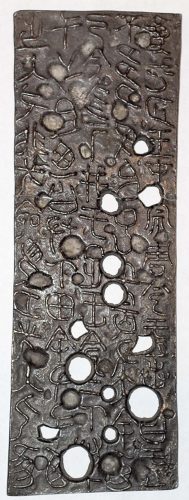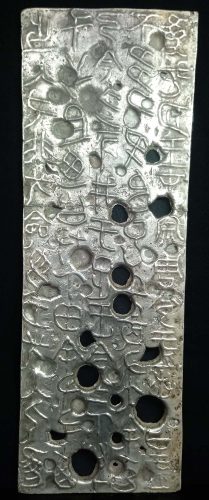A few years ago I bought a metal plate at an auction that tickled my curiosity. On it were jinwen characters, in relief and mirror writing. The first line The first line contains the beginning of the text of the 大盂鼎. The plate measures 9.5 by 27 cm and weighs approximately one kilo.
Recently, I decided to see if I could clean the plate. What turned up from under the dark brown tarnish was a silver shine.
The first picture is as I acquired it. The second, after cleaning.
When I cleaned the plate (with water and baking soda) I noticed that the tarnish that came off had a strong smell of smoke.


My research
After discovering that the first line came from the 大盂鼎, I searched online, and came across the a PhD dissertation which discusses this text by a researcher from the University of Chicago. I emailed him and he was so kind to mail me back with his thoughts.
To him, in summary, it seems to be a relatively modern piece which used the style of the calligraphy from the 大盂鼎 as inspiration and kept a bit of the phrasing, but with the exception of the first line, in no place does it seem to faithfully represent any other complete units of the text. Furthermore, although the calligraphy is stylized to a great extent, many graphs deviate from known versions, and there are also strange constructions and dropped graphs.
He concludes: “At any rate, your piece is both bizarre and somewhat intriguing– if you’re going to make a bronze piece with ancient calligraphy on it, you might as well choose 金文, and
copying (with a good deal of artistic license) the forms of the graphs from the 大盂鼎 inscription makes good sense”.
As a university-trained sinologist, but not an expert in this field in any way, I can only agree.
My thoughts
Given the predominant smell of smoke that was released when I washed off the brown tarnish, it could well be that the object was buried in the ruins of a building that burned down during a fire.
That leaves the question of why the object exists at all. And why is it silver coated?
I realize that these questions may never be answered, but this piece has aroused an interest in me to know more about the original jinwen bronzes and their legitimate reproductions in later times.
This piece is clearly not a ‘forgery’ for the modern global marketplace. But then what is it?
Could it be that someone in the past made this piece as a ‘practice piece’ for a reproduction? Or perhaps the piece began as a reproduction, but became a practice piece when he noticed that he had forgotten a character (after the ninth character of the … …is missing)?
My questions
1. has anyone come across anything like this?
2. Does anyone know anything about the teaching methods used to reproduce old bronze vessels and inscriptions in later centuries?
3. Are there ways to estimate the age of an object like this based on its physical characteristics?
